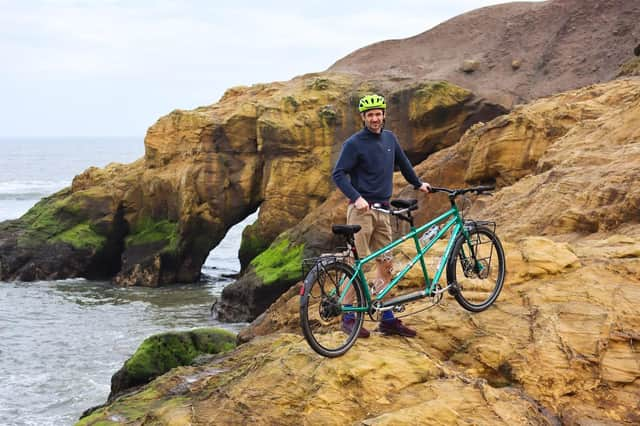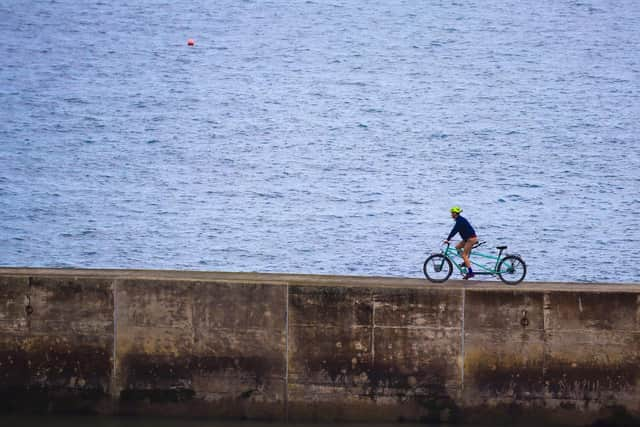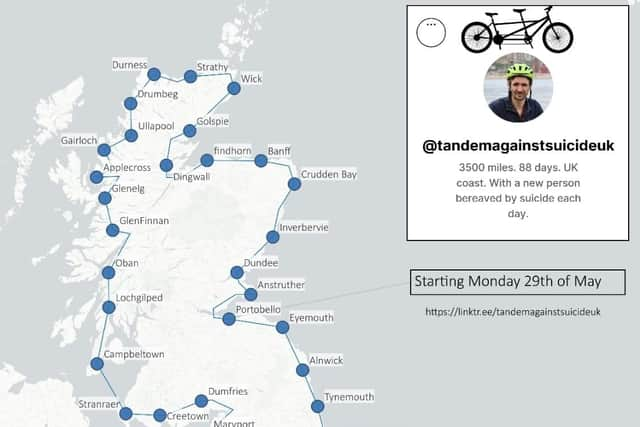Edinburgh man cycles coastline for Tandem Against Suicide challenge in sister's memory


A tandem is made for two, so one empty seat is a poignant sight.
That’s possibly one of the reasons 34-year-old Xani (Alexander) Byrne chose this type of bike to do his 88 day and 3350 mile Tandem Against Suicide challenge round the coast of the mainland UK.
Advertisement
Hide AdAdvertisement
Hide AdAnother is because he and his sister, Alice, who he lost to suicide in January 2022, had always hoped to cycle the streets of the Capital on one. Unfortunately, to Byrne’s “huge regret”, they didn’t get round to it.


“So, this isn't a ride with Alice, but it is a ride for Alice and for everyone who struggles with suicidal thoughts,” says Byrne, who is raising funds for SOBS (Survivors of Bereavement by Suicide) and Papyrus UK (Prevention of Young Suicide) through his JustGiving page, and has already hit around 15k in donations for each charity.
He set off on his turquoise steed from Edinburgh’s Portobello on May 29, taking the circuitous route via Cardiff, Dumfries, Oban, and the village of Drumbeg, where I speak to him on the final leg of the journey. So far, it’s been mentally and physically tough, but he’s had some beautiful moments, from cycling into Applecross and riding past horses in the New Forest, to whizzing down hills in Yorkshire.
For each segment of the journey, Byrne, who quit his job to take on this challenge, has welcomed a guest who has been affected by suicide, to pedal and chat with him about their bereavement
“About 30 per cent are people that I know. So there were friends of ours and my mum joined it at the beginning,” says Byrne, who’ll return home on August 24. “The rest are through social media and the charities. Many are strangers. That's been really good because it's got me away from my bubble of people. They’re from very different backgrounds. And I found that really useful”.


As well as the essential awareness-raising, this has been a therapeutic exercise for Byrne and his co-pilots, who are all in different stages of grief. There are those who lost someone decades ago, and haven’t talked about it since, and others who have had a more recent loss.
According to him, losing someone through suicide can raise unique emotions and questions - as Byrne says, “going nowhere, and torturing yourself” - that are particularly tricky to navigate.
“It's really important to talk about the people we've lost, and what we’ve learnt, despite the difficulty. You do end up with all this knowledge and you try to pass it on,” says Byrne. “We've been talking about the positive memories, because when you lose someone to suicide, they can become defined by that, and that reduces the person. So I've had really good conversations with amazing people. And it's been really heartening. When I was in coming down into Glenelg, across from Skye on the Kyle Rhea ferry, friends came to meet us and literally took the baggage off the tandem, which they put on their own bikes, and I thought that was a really nice visual metaphor for how you cope with grief - sharing it with friends and letting yourself be supported. You're able to go further and continue when you thought you might have stopped”.
Advertisement
Hide AdAdvertisement
Hide AdAccording to Byrne, in his two-wheeled quest to connect, he’s met “police officers, artists, musicians, authors, bricklayers, farmers, stonemasons, sailors, teachers, doctors, lawyers, I could go on”.
“The point I’m trying to make is that suicide does affect everybody. I was really hit by that when I was in the Highlands. I was told that it has one of the worst suicide rates in Western Europe. And when you're looking around and you see the forestry out there - these felled trees look like tombstones. It seems that we can try a bit harder”.
Byrne feels that society deals with mental health problems poorly.
While on his trip, he watched a ‘man overboard’ procedure on a boat in Campbeltown. The crew knew exactly how to respond, when it came to a practice involving rescuing a dummy from the water. He thinks there should be a concerted effort from “schools, offices and places of work” to learn how to respond when employees and pupils feel depressed.
“For fear of saying the wrong thing, people will say nothing at all. That can be more harmful,” says Byrne, who recommends the book, When It Is Darkest by Professor Rory O’Connor. “They can also use euphemisms, so they might say ‘you're not thinking of doing anything stupid?’ when they need to ask if someone is feeling suicidal. They fall into some of the common traps and myths, where they think that if they ask about it, they're planting the idea in somebody's head. They also think it's more likely to happen in certain groups and therefore not happening in others. And that's not the case, suicide happens across all walks of life”.
In the spirit of talking about loved ones, Byrne is happy to describe his younger sister, who would’ve surely been proud of his challenge.
“She would have teased me and made jokes and been sarcastic. She would have done all those things she would do but, yeah, I think secretly she would have been proud. She was funny, so well read, loved music, and was really kind, caring and just kind of motivated to help people. So yeah, she was just lovely”.
To donate to Byrne’s charities, see www.justgiving.com/team/TandemAgainstSuicideUK